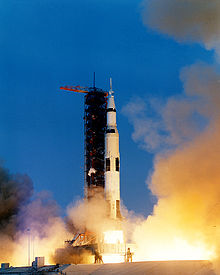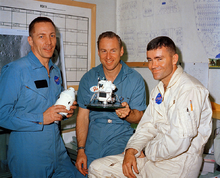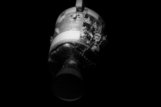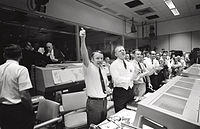Apollo 13 was the seventh manned mission in the US Apollo space program and the third attempt to land human beings on the moon. The mission was aimed at exploring the Fra Mauro Formation, a vast hilly area believed to have formed from the ejected materials when the Mare Imbrium formed. Unfortunately, the landing was aborted due to an accident that occurred in space. This article looks into the Apollo 13 mission in details. Read on to learn why this mission is considered a successful failure.
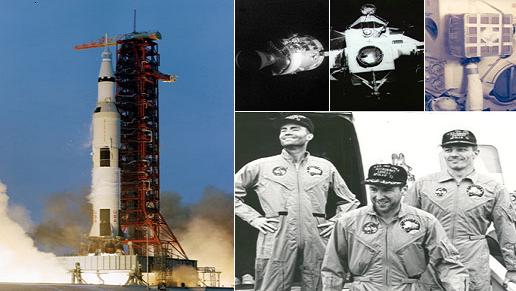
The Apollo 13 Spacecraft
The Apollo 13 spacecraft was made up of two spacecrafts- Odyssey and Aquarius. During the flight, the crew lived in Odyssey, which was the command module (CM). Aquarius was the lunar module (LM) that was supposed to be the lander but served as a lifeboat after the explosion.
The Apollo 13 Launch
The mission began on April 11, 1970 when the spacecraft launched from the Kennedy Space Center launch pad in Florida. Just a few minutes after liftoff, one of the engines shutdown and the crew sensed a slight vibration. However, the other engines burned longer to compensate for this shutdown and put the ship in orbit. Other than this, it was a smooth launch.
Apollo 13 Launch Image Source
The Apollo 13 Crew
The commander of the Apollo 13 spacecraft was James A. Lovell, Jr. He was the most traveled astronaut in space at the time having gone for 3 missions and 572 space flight hours. John L Swigert, Jr. was the command module pilot. He was a last minute replacement after Ken Mattingly was exposed to German measles and grounded by the flight surgeon because he had no immunity. Fred W Haise, Jr. was the lunar module Pilot. The real life and training experience possessed by the crew was very crucial in dealing with the problems they were to encounter later in this mission.
The Apollo 13 Crew Just Before the Launch Image Source
The Apollo 13 Accident
The first sign of trouble occurred when the crew was 200,000 miles from Earth. The mission controller noticed a low-pressure warning signal on a hydrogen tank in Odyssey. This could have been a sign of a problem or just an indication that the hydrogen needed resettling through heating and fanning. In this case, it was a sign of a bigger problem, as an oxygen gas tank exploded after about 56 hours of flight leading to the loss of the service module (SM) that the command module relied upon and crippling the spacecraft.
There was a sharp loud bang and oxygen pressure fell. Alarm lights were blinking, electrical power was fluctuating and the attitude control thrusters were firing. Their immediate thought was that a meteoroid had hit the lunar module. The crew notified mission control and Swigert uttered the famous statement, “Houston, we’ve had a problem.”
The Damaged Service Module Image Source
What Was Done To Save The Lives of The Crew?
After the explosion of one of the cryogenic oxygen tanks in the service module, measures had to be taken to save the lives of the crew.
First, the landing was aborted so the crew orbited the moon without landing. With the damage to the service module, a safe return to Earth after a landing on the moon would have been impossible and the flight director had no option but to cancel the landing. The abort was done through a circumlunar option, using the Moon’s gravity to return the spacecraft to Earth.
After the second oxygen tank exploded and the first oxygen tank failed, the source of electricity, light and water for the command module was lost. Oxygen was escaping fast from the single remaining oxygen tank. All efforts to seal the oxygen leak failed and power reduced in the command module. The crew had to shut the command module down and rely on the lunar module as a lifeboat. While it lacked a heat shield, the lunar module could ensure the crew remained alive long enough to last the trip back to Earth.
What Was It Like for The Crew After The Accident?
After the explosion and migration to the lunar module when the command module was about to shut down, the first concern for the crew was the availability of consumables. The lunar module was designed to support two people for 45 hours and here it was required to support three people for 90 hours.
Oxygen was not their biggest problem. There was enough supply in the descent tank, ascent-engine oxygen tanks, two backpacks, and emergency bottles. . Water was their biggest concern and they had to conserve the little they had. Food was not enough, as some of it was lost after the explosion. They drank fruit juices, ate hot dogs, and wet-pack foods. They became dehydrated and lost a lot of weight. Power was another problem and they had to shut off non-critical systems to conserve it. After turning off the electrical systems, temperature dropped to 38F and there was condensation on the walls. Sleep was hard to come by because of the extreme cold.
Removal of carbon dioxide was also a problem as the lithium hydroxide canisters in the command module designed to remove carbon dioxide were square and not compatible with the round openings of the lunar module environmental systems. The crew had to improvise a way to connect the two systems using available materials.
What Was It Like on Earth After The Explosion?
The television systems on the spacecraft were turned off due to power shortages and live streaming of the events was not possible. Televisions broadcasted the event using models and animated footage.
The flight director, mission control teams and spacecraft manufacturers all worked hard to support the crew, help them manage resources and carry out their daily activities to ensure a safe return to Earth.
Mission Control Celebrate the Successful Return of Apollo 13 to Earth Image Source
The Apollo 13 Crew Return To Earth after the Explosion
When the explosion occurred, the crew had already left the free return to earth trajectory and were on a lunar landing course. How to get back to earth safely after the accident was therefore a major concern. First, they had to get back on a free-return course. Ground controllers had to decide and test how, when and what attitude to burn the lunar module descent engine to provide a quick return to Earth.
To keep the life support and communication systems alive until reentry to Earth, the lunar module was powered down to the lowest levels possible. The abort guidance system was used to return to Earth instead of the primary guidance system because it consumed less power and water. There were huge risks of short circuits when powering the command module after its long cold sleep. Luckily, mission control developed procedures to power it up safely.
Four hours before landing on Earth, the crew shed the damaged service module that had been retained to shelter the CM heat shield from the extremely cold space. The crew left the lunar module on parachute and splashed safely in the South Pacific Ocean near Samoa on April 17. The crew landed on earth in good condition except for Haise who suffered a serious urinary track infection because of dehydration.
Apollo 13 Crew Land on the Pacific Ocean Image Source
What Caused the Accident?
After the safe return of the crew to Earth, the Apollo 13 Accident Review Board was set up to investigate the cause of the explosion. The investigation showed that there were exposed wires in the oxygen tank due to manufacturing and testing errors before the flight. The oxygen tank had also been damaged by exposure to too much heat. The tank was like a time bomb waiting to explode. A spark from an exposed wire in the oxygen tank caused the explosion.
When the first tank blew, it either ruptured a line on oxygen tank 1 or caused one of the valves to leak. This explains the oxygen leak that followed. As a result, future spacecrafts were equipped with better wires and an extra tank to prevent a similar problem from occurring.
Why Was The Apollo 13 Mission Referred To As a Successful Failure?
Apart from the fact that the Apollo 13 crew returned to Earth safely, the mission also accomplished some of its objectives that were initiated before the accident. It captured photos of earth, set up an active seismonic experiment and provided information on conducting a launch in less than ideal weather conditions.

